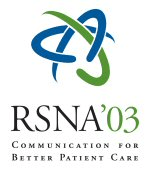Abstract:
HTML
Purpose: The recent advances, such as development of ultra-fast gradient, rapid sequences and integrated panoramic array coil (IPA), have made MRI more feasible in accomplishing whole body scanning with high signal-to-noise ratio within acceptable scanning time. We try to implement new protocols for whole body MRI for the screening of occult neoplastic disease and asymptomatic vascular lesions among healthy subjects.
Methods and Materials: MRI is performed on a 1.5T clinical scanner with IPA hardware (Sonata, Siemens, Erlangen). Ultrasound (US) is routinely performed in each case adjuvant to MRI and is used as guidance for biopsy (Elegra, Siemens, Erlangen). The study group is mainly consisted of healthy individuals recruited as self-referral. The following four different programs are provided. 1. Tumor program: covering from head to pelvis including entire spine. US is performed as complementary exam for superficial parts and as adjuvant exam to provide additional information regarding calcifications. 2. Stroke program: both brain MRA and contrast-enhanced carotid MRA. Duplex US is routinely applied for the plaque characterization and hemodynamic assessment. 3. Cardiac program: left ventricular functional assessment, valvular function, myocardial perfusion and viability. 4. Breast cancer program: dynamic breast MRI conjugated with US. The time normally taken to complete the examination ranges from 55 to 95 minutes.
Results: A total of 3274 cases (M:F=3:2, mean age:54.3 y.o.) had enrolled in whole body MRI screening over a 18 month period. And among those, 1985 cases had also chosen brain and carotid MRA. A total of 445 cases had undergone breast MRI. And 352 cases have undergone cardiac MRI. The preliminary results showed 132 cases of neoplastic diseases (4.0%). And among them, 61 cases are malignancies (1.9%). There were 224 cases found of vascular lesions (11.3 %) which need medical attention. Marked vascular stenoses were found in 181 cases (9.1%). Sixteen cases of asymptomatic subjects with abnormal myocardial perfusion test had been proved of coronary arterial disease(4.5%).
Conclusion: MRI and US are the least non-invasive imaging tools known, and so that the debatable issue regarding excessive radiation and the risk of adverse reaction from iodine contrast medium in CT screening definitely can be spared and moreover, the sensitivity and the specificity are surely much better with MRI. The results we have obtained so far have enlightened the potentiality of whole body MRI for check up in healthy or asymptomatic individual.
Questions about this event email: jscko@yahoo.com.tw
Ko MD, J,
The Feasibility of Whole Body MRI Screening. Radiological Society of North America 2003 Scientific Assembly and Annual Meeting, November 30 - December 5, 2003 ,Chicago IL.
http://archive.rsna.org/2003/3107893.html

